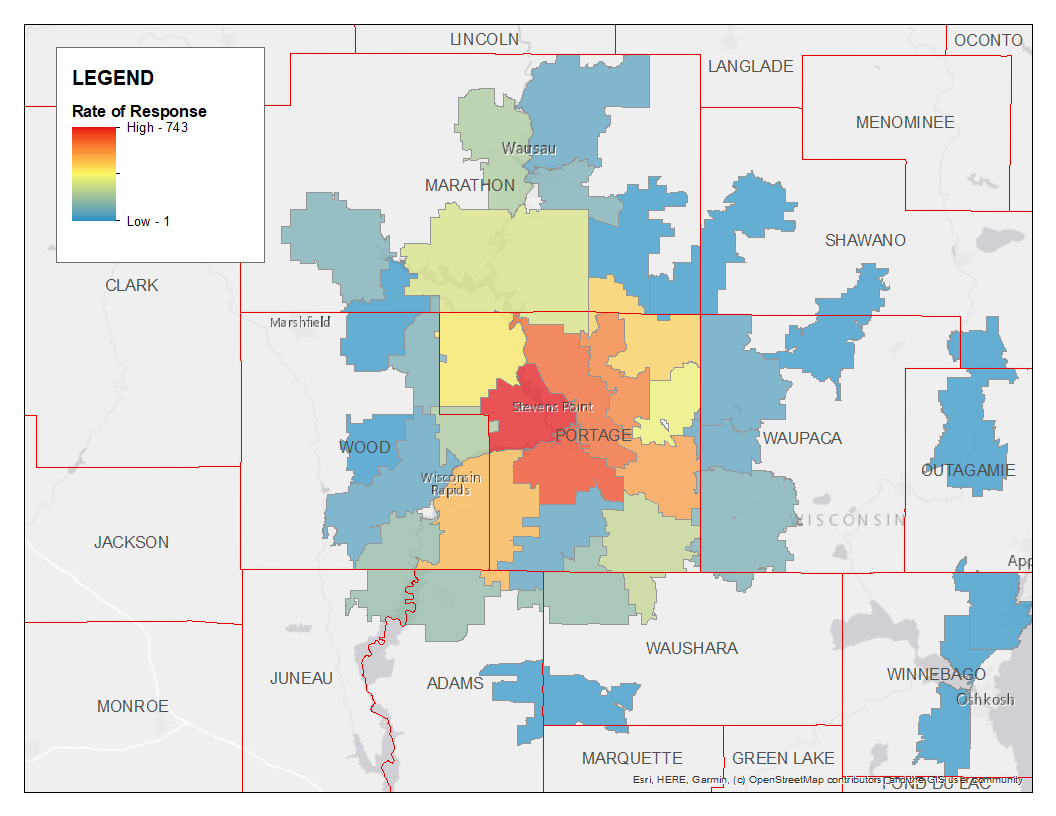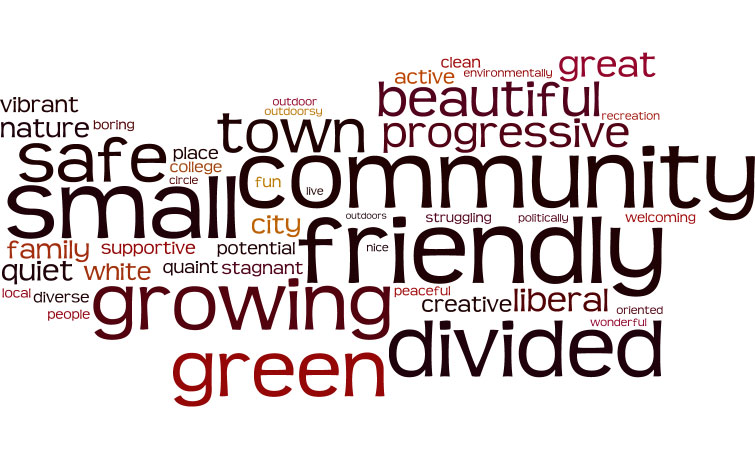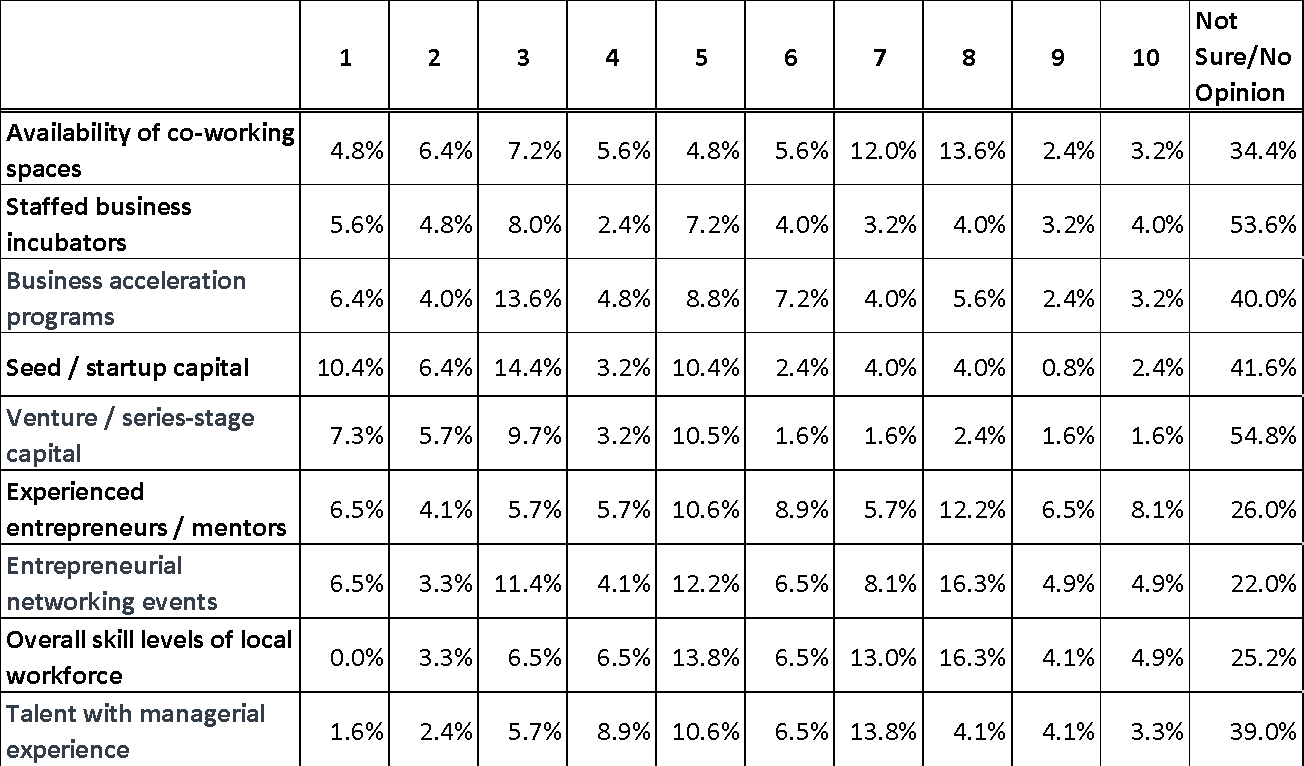Background
In February 2020 the City of Stevens Point, WI released a Request for Proposals to create a Strategic Plan addressing local challenges and developing a vision for the city’s future. Through a competitive bidding process, the city selected and partnered with Atlas Community Studios of Des Moines IA, and locally-based CREATE Portage County.
Beginning in the summer of 2020 and through the additional challenges of a global pandemic the city, Atlas, and CREATE worked together to develop a strategic action plan through creative placemaking, a collaborative and locally driven approach to building strong, vibrant communities.
Scope of Work
The contracted Stevens Point Strategic Plan process scope of work includes five key elements:
- Creation of a local Steering Committee of top local public and private leaders to guide the process.
- Collecting Stakeholder input through public visioning sessions, an online public survey, interviews and focus groups with key stakeholders.
- Community Assessment to evaluate quantitative trends for Stevens Point compared to local, state and national data, incorporate key themes from public input sessions, and identify priorities to inform development of the Strategic Plan.
- Development of a Strategic Plan guiding the city’s future trajectory, identifying and confirming overarching goals and key opportunities to enable Stevens Point to achieve its vision with a holistic focus on job and talent development, quality of life and place, diversity, equity and inclusion, and connectivity.
- Development of an Implementation Action Plan to operationalize the Strategic Plan with assessments and recommendations necessary to implement including personal, programs, partnerships, and funding resources.
Purpose
The purpose of this plan is to help the City of Stevens Point create a strategic vision and implementation strategy that will guide public and private activity for years to come.
Everyone in and outside of the community should be able to see their opportunity to participate in achieving the vision.
For local residents and the workforce: The plan should inspire and foster local champions to take action in both identified and new opportunities to create a better community for all.
For potential residents: The plan should be an attractor demonstrating the unique assets, values, goals and opportunities of Stevens Point.
Why Placemaking?
While countless communities across the country face similar challenges to Stevens Point, what sets the city apart is the eagerness to find innovative solutions and take action to shape the future of the community, build an equitable economy, attract and retain top talent, and improve the overall quality of life for generations to come. To achieve these results, a different approach is needed.
Atlas’s approach to planning is through creative placemaking, a people-centered approach to building strong, vibrant communities. Public engagement is critical to the placemaking process and helps create a unified vision and sense of shared ownership in the future of the community.
Placemaking leverages unique community assets to solve big challenges through catalytic concepts and projects – building momentum to create a domino effect of more positive change.
This approach gives Stevens Point the opportunity to not only improve incrementally but really push for what’s possible on a grander scale. Why should larger metropolitan areas be the only places with creative innovative solutions to community development? Stevens Point could easily become the model for implementing positive change.
The overarching goals of the placemaking process are:
- Economic and social development
- Increase population and/or tourism
- Improve the overall quality of life
Visioning
Introduction
To kick off the process Atlas Community Studios with support from the City of Stevens Point and the Steering Committee hosted a variety of public input sessions.
The goal of these is to gather feedback and ideas from any and all area stakeholders on local challenges, needs and to establish a unified vision for the future. All efforts were made to reach out to constituencies that represent the full diversity of Stevens Point.
In total the team:
- Created an online community survey for all interested Stevens Point stakeholders received 1,350 responses
- Hosted 2 open-invitation public visioning sessions and one visioning session with the steering committee
- Hosted 9 virtual focus groups of key identified constituencies
- Conducted 12 individual interviews with various key leaders and stakeholders
- Presented to the Common Council on overall project goals and welcomed feedback
Key Themes
Strengths
- Outdoor recreation/Natural Resources
- Access to nature/Parks
- Green Circle Trail
- Sense of community/Small town feel
- Location
- UWSP/College town feel
- Downtown
- Farmers Market
- Local food
- River
- Diversity
- Focus on sustainability
- Arts and culture
- Affordable living
- High quality of life
- Diversity of economy
Challenges
- Housing – Appropriate options/varieties of styles and prices
- Underutilized riverfront
- Diversity and inclusion
- Green Circle trail access from city
- Declining population
- Lack of neighborhood feel
- Need for year round activities/venues
- Community gathering spaces
- Lack of identity
- How to grow and maintain small town feel
- Lack of connectivity/public transportation
- Options for downsizers
- Old housing stock
- Blighted properties
- Not truly welcoming/inclusive
- Divisiveness
- Need for non-student focused entertainment options
- Live entertainment
Community Input Results
What follows are selected highlights and responses of all of the community input sessions.
You can read the full report using the button below.
Community Survey Results
The Stevens Point Strategic Plan Community Survey was available online from July 20 to August 31, 2020 and garnered 1,345 responses. It was available to all stakeholders who wanted to participate and could be accessed via the city of Stevens Point website or through links sent via email or posted to social media. The survey was promoted via traditional and online media and sent to distribution lists of multiple local organizations, institutions, and businesses.
The survey was not intended to be a statistically representative demographic sample of Stevens Point’s resident base but rather an opportunity for all area stakeholders to lend their voices and perspectives to the city’s strategic planning process. Even so, all efforts were made to reach out to constituencies that represent the full diversity of Stevens Point.
For certain of the survey questions, Atlas has developed “word clouds” to demonstrate the tenor of respondents’ open-ended answers. The larger the word the more frequently that word was used by survey participants.
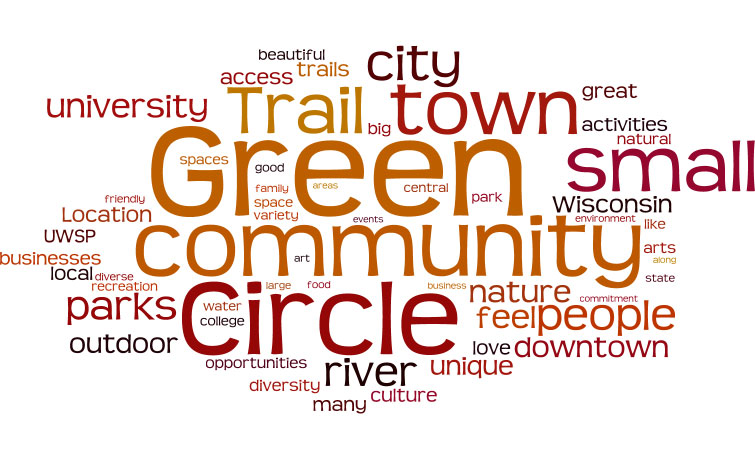
Selected individual responses:
- “It’s central location to larger cities (Green Bay/Appleton – Madison/Milwaukee) and the Green Circle Trail.”
- “The creative business environment. There are many unique businesses that are doing regional or even national business headquartered in Stevens Point such as Sentry, Skyward, and others.”
- “Accessible and active downtown area. Lots of things for a wide variety of interests: library, farmers market, children’s museum, parks, restaurants, music venues, shops.”
- “2nd oldest brewery based upon consecutive years brewing in the country.”
- “As someone that has grown up in the city and what it used to be and the quiet streets by 9pm, I love how there are so many events from art to music to food to attend or be involved with. The biggest, most unique, most amazing thing is access to amazing, locally grown, clean, healthy, sustainable food.”
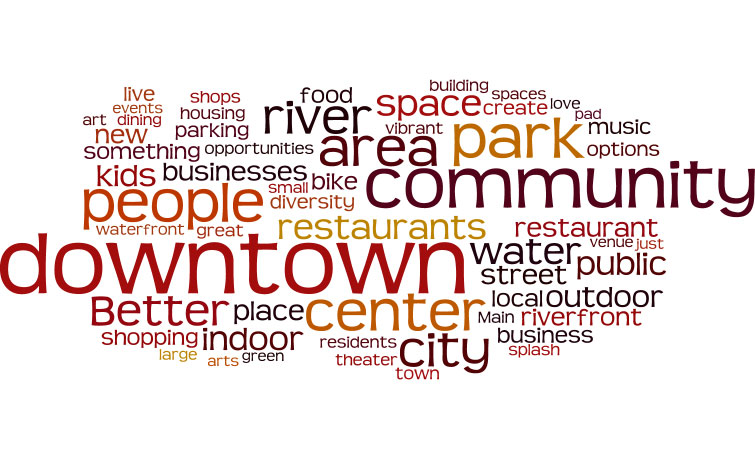
Selected individual responses:
- “A shopping/business/restaurant area that could be planned to allow growing accessibility from the Wisconsin River. We have jobs, but not enough people and this is needed to attract and keep people who come here to work.”
- “Utilize the riverfront more. I think developing some of the riverfront would draw in more people to visit and live here.”
- “Family friendly water park/splash pad. We have nothing that very little kids can enjoy.”
- “A cultural community center/hub, something that celebrates, promotes, and increases the diversity of the area, enhances cultural understanding and opportunities, etc.”
- “Though there has definitely been progress, I’d say further work towards making it easy and safe to get basically anywhere in the city via bike.”
- “A better sense of inclusion, I know that city officials are working hard to create this already and it is greatly appreciated, but there has been a lot of intolerance and negativity that has been getting more attention recently.”
- “Inclusive, large civic center as a place for gathering even in winter months. A place that is supported by the community (taxes), but also by users (rental or user fees) so there is a sense of investment.”
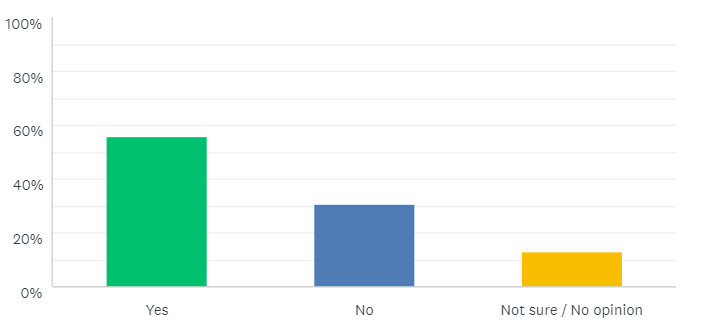
If you answered “no,” what could be done to make Stevens Point more inclusive?
Selected individual responses:
- “Have more festivals that focus on culture. The cultural fest is great but it’s only once a year & has a focus on many cultures. Would love to see activities focusing on Hmong population & Native Americans for example.”
- “I think we are seeing progress, with the creation of a diversity committee, but I also think this is an area that can always do better.“
- “Involve people with lived experience on boards, committees, and in leadership roles to help our community understand what we can do better. It is through their lens that change will happen”
- “I think UWSP is a huge part of what shapes the city and gives it life, and I was proud of how integrated the university was with the surrounding community. I come from another small town in WI, and the quality of that city compared to Point is dismal. I’m proud to be a Pointer, and I hope the city keeps up all of the amazing aspects that make it a great place to live.“
- “The city of Stevens Point has a lot of great things going for it, however in order to keep up with the needs of its citizens and future generations, it must continue to innovate. This will be a combination of promoting economic diversity, as well as individual diversity in the populations and overall social welfare.”
- “I think a future in Stevens Point needs to keep including anyone and everyone. I feel that we do it well here but there is always room for improvement and making people knowledgeable.”
- “Our city is looking for an identity. Our parks and access to nature make us Point. Our focus should remain Environmental Sustainability & Education, The Outdoors & Recreation (especially all-season bicycling and disc golf), and Local Food & Farming.”
- “I am one segment of the population and I probably fall into the category of an engaged citizen who feels like my voice is heard and that I have a lot of opportunity here. I am certain that is not the case for many other citizens of Stevens Point. We have to find a way to make sure everyone in our community has a voice.”
- “I think this small town has a lot of potential to be a unique cool town that’s also family friendly.”
College Students
The following responses are from survey participants who self-identified as college students.
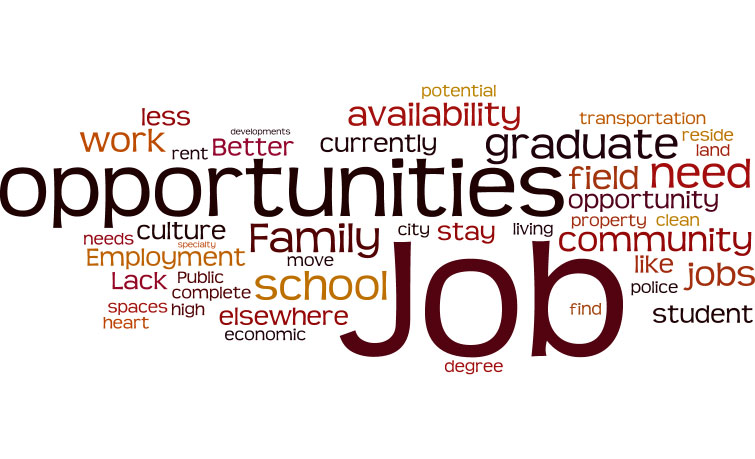
Selected individual responses:
- “I’d like to stay if there was a job opportunity in a field I studied in.”
- “Needed to leave the state for a graduate school opportunity. I am hopeful that my future will bring me back to Point someday.”
- “I am a recent graduate of UWSP. I want to stay (and am currently staying) in Stevens Point because of many factors – affordable living, connected and conscious community, an abundance of kindness and good-valued people, CO-OP initiatives, clean water, clean air, heart of Wisconsin. I am currently not feeling the need to move elsewhere because I have been able to find jobs that allow me to stay. However, that is because my interests are broad and abilities are flexible – I am able to find different niches and am not constrained to one area of specialty.”
- “Lack of performance venues and places to work on art after graduation. No professional level training”
Entrepreneurs
The following responses are from survey participants who self-identified as entrepreneurs.
Selected individual responses:
- “We need more entrepreneurial meetings at a local level for marketing or even inspiring new startups or partnerships.”
- “Stevens Point is a very friendly town, however it can be difficult to establish a professional network as someone who has no connections to the area.”
- “More innovative options for seed money, financing, public-private partnerships, creating Stevens Point having a particular focus for what it is best at, etc.”
- “Information outreach in regard to entrepreneurial opportunities here in Stevens Point. Perhaps some kind of localized focused source of this info widely communicated through various local media.”
- “I don’t think the goal should be a movement toward ‘more competitive’, but rather, ‘more cooperative’.”
- “Affordable working spaces for young/emerging artists”
- “Help with training on start up and mentoring first year”
- “Partnering with organizations like Doyenne in Madison to provide female-focused entrepreneurial resources.”
- “More outreach to surrounding communities. I live in Kronenwetter but come to Stevens Point often. I would be interested in participating in entrepreneurial networking opportunities.”
- “I think it would be nice to have more places like CREATE that actively seek to help grow new and existing business via the right connections. Also, it would be nice to see a panel of investors that new entrepreneurs could come talk to and seek advice and resources from.”
Visioning Session Results
Two open-invitation visioning sessions were held for all interested Stevens Point stakeholders to participate in an online exercise to provide their feedback on the city and its future.
One session was held the afternoon of August 5 and the second the morning of August 6. The sessions were promoted via the media and on the city’s website.
The following are the results from the Poll Everywhere voting for each visioning session. This information as well as other feedback from the sessions were incorporated into the Stevens Point Community Survey.
- Most of the respondents in both visioning sessions have lived in the Stevens Point area for over ten years
- General sense of Stevens Point’s quality of life was that it was “good, but could be better”
- Need for more affordable housing options probably the most consistent takeaway from the sessions as well as improving the quality of existing housing and protecting against gentrification
- Overwhelming percentage of respondents answered “yes” to the question, “Have you, or someone you know personally, struggled to find appropriate housing in Stevens Point?”
- Strong appreciation for arts, culture, and recreation amenitites and desire for even more options
- Multiple participants cited University of Wisconsin-Stevens Point as one of the community’s top assets
- Desire for greater population diversity in Stevens Point and more inclusiveness for existing minority residents
- Considerable feedback about the riverfront and opportunities to better connect it to downtown and develop new amenities, though not at the cost of the environment
- Many calls for more diverse employment opportunities, including cooperatives
- Preference from many respondents for enhanced public transit, including a downtown trolley
- Range of opinions on what is needed to improve Downtown Stevens Point, from more housing and arts amenities to improved recreation infrastructure like bike paths and more family-friendly retail options
- Wide variety of answers to the question, “What would you like Stevens Point to be known for?,” with many responses stressing a sense of “community”
Focus Group Results
Nine focus groups were held during the month of August via Zoom with constituencies from across the community. Interactive voting was conducted using Poll Everywhere software. Sessions included:
- Retirees and Downsizers
- Arts and Culture
- Innovation
- Sustainability
- Education
- Small Business
- Health and Wellness
- Young Professionals/UWSP Students
- Diversity, Equity and Inclusion
A core team of local leaders provided input for Atlas on the potential attendee rosters for each group. Attempts were made to incorporate stakeholders representing minority or disenfranchised populations into the categories listed above. However, the core team decided that a focus group specific to diversity and inclusion issues was also necessary. That group will be held later in September.
The following are the results from the Poll Everywhere voting for each focus group. This information as well as other feedback from the sessions were incorporated into the Stevens Point Community Survey.
Community Assessment
Introduction
The Community Assessment features high-level quantitative trends for Stevens Point compared to the United States, the state of Wisconsin, and three peer cities, Eau Claire, Wisconsin, La Crosse, Wisconsin, and Marquette, Michigan.
It incorporates key themes from stakeholder input to determine how Stevens Point competes for jobs and talent.
The assessment combines research, existing reports, and various data sources to identify key trends and issues and inform Stevens Point’s vision and strategic opportunities.
Key Trends & Issues
The Stevens Point Strategic Plan process includes a holistic look at key trends, issues, opportunities, and challenges the city faces to achieve its preferred future. Quantitative research combines with comprehensive stakeholder outreach to ensure that Stevens Point’s strategic priorities reflect the community’s vision.
The following key trends and issues emerged from the quantitative and qualitative research conducted for this Community Assessment.
1) Balancing green sensibly with desire for amenity development.
- Across all the forms of stakeholder input, Stevens Point’s recreation amenities, green spaces, and culture of environmental sustainability and natural resource protection were cited as the city’s most unique and defining features.
- Balancing Stevens Point’s green sensibility with the desire of many local stakeholders to enhance the city’s quality of life through the development of new amenities – especially along the Wisconsin River – pits the community’s stewards of natural resources versus residents and businesses looking for more “big city” amenities
2) Will Stevens Point have enough talent to support businesses?
- Census data show that over 77% of the Stevens Point’s workers live outside the city and commute in.
- Stevens Point’s population has declined 3.1% since 2010, while growth in Portage County has been flat. More concerning is that Portage County is seeing many more domestic residents leave the community than move there.
- Data from the IRS show that most people leave Portage County for larger metros like Madison and Minneapolis or adjacent and near-adjacent Wisconsin communities
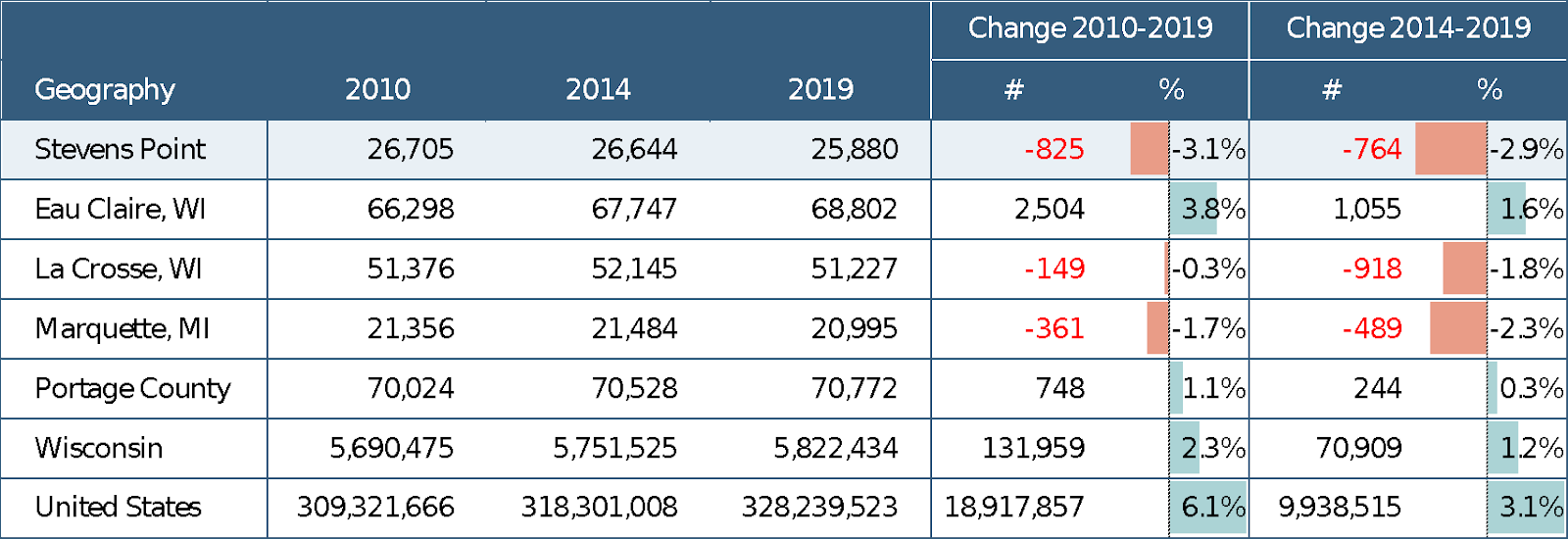
- Stevens Point was the only area analyzed besides the U.S. to see a decline in its 18 to 24 year old age group from 2013 to 2018. When college students were asked on the online survey what might cause them to leave Stevens Point even if they wanted to say, most answered “job opportunities.”
- Stevens Point’s talent pipeline is strong.
- Data show that Stevens Point Area Public School District students consistently score better than their Wisconsin peers on statewide proficiency exams. Stevens Point high schoolers also graduate at higher rates than statewide peers.
- Combined, University of Wisconsin-Stevens Point and Mid-State Technical College (MSTC) awarded 2,719 degrees in the 2017-18 academic year, a higher number per capita than all the benchmark cities.
- Stevens Point has a higher percentage of adults with graduate and professional degrees than all the comparison geographies and trails only Marquette, Michigan in bachelor’s degree attainment levels.
- Feedback from employers and economic development officials identified areas of concern for Stevens Point, including large gaps in workforce availability for positions in the “trades” and a struggle to retain employees when they decide to purchase a home but can’t find one that meets their needs.
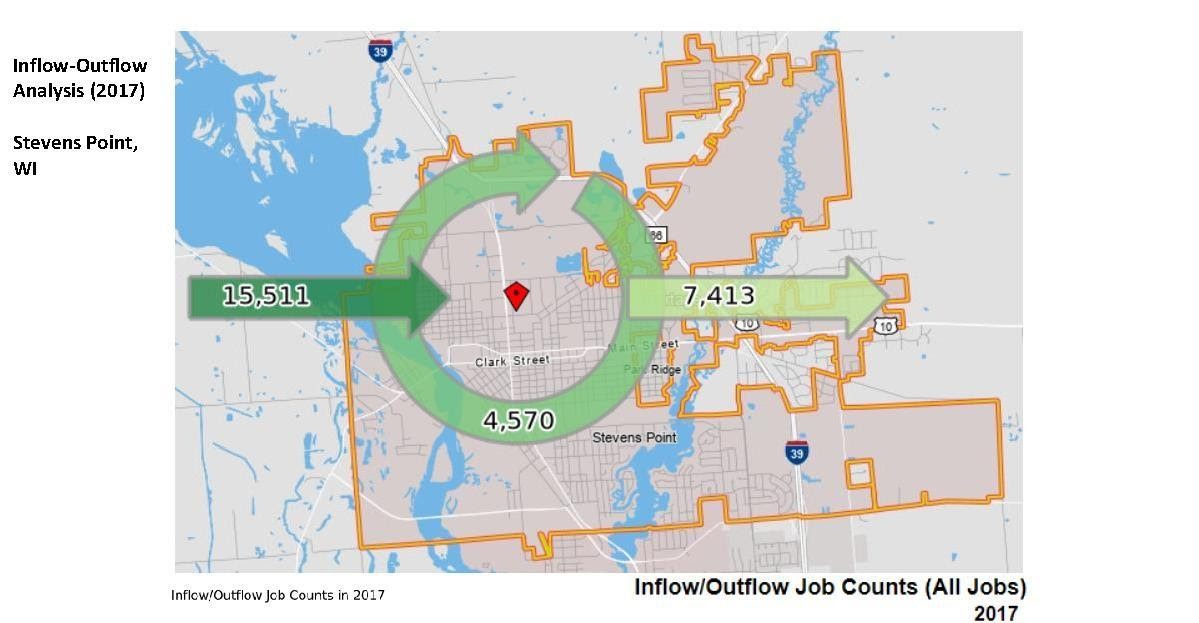
3) An array of housing challenges.
- There is a mismatch between housing supply, demand, and price point. According to stakeholders, in Stevens Point, you can find a “fixer-upper” entry-level house or a new-build for $300,000 to $350,000 and up, but little in between.
- Stevens Point for-sale housing is affordable, but there is price escalation for the most in-demand units. On the rental side, nearly 50% of Stevens Point renters pay more than 30% of their income on rent, which is in line with most of the comparison areas and lower than the national rate.
- There are signs that the pipeline for new-build multi-family rental is improving, with over 1,700 beds coming online in the next six to ten months in Stevens Point and Plover.
- The 2017 Stevens Point Housing Study found that Stevens Point needs more new single-family homes, especially downtown and along the riverfront.
SELECTED HOUSING COSTS CHARACTERISTICS, 2013-2018

4) Wealth and poverty trends are consistent with comparison cities.
- Portage County’s wages are in line with the other college towns analyzed in this report but trail the state and national figures. However, Stevens Point’s lower per capita income demonstrates that many adults are relying on income from government payments and investments instead of wages.
- In a positive sign that wealth trends are moving in the right direction in Stevens Point, the city has seen the largest decline in total poverty of all the comparison areas and has the second-lowest rate among the comparison cities.
- Child poverty also remains comparatively lower in Stevens Point than in two of the three comparison cities, Wisconsin, and the U.S.
- The ALICE indicator calculates households that earn above the Federal Poverty Level but not enough to afford a bare-bones household budget. As with poverty data, Portage County’s ALICE rate compares favorably to the benchmark counties.
PER CAPITA INCOME, 2013-2018

5) Stevens Point is becoming more diverse, but is it welcoming and inclusive?
- Stevens Point is the most diverse of the comparison cities in this study, though not by large margins. Change data shows that Stevens Point’s diversification has gained momentum in recent years, especially in the growth of the Hispanic or Latino and Black populations.
- On the community survey, the majority of respondents believed that Stevens Point was both welcoming and inclusive. However, nearly 6% more minority respondents disagreed that the community was inclusive of its diverse populations than the overall response rates.
- Minority stakeholders in public input said that race relations have improved in Stevens Point, but forms of aggression have changed from violent fights to “microaggressions.” Many do not feel safe in the city due to racial profiling and overt and subtle forms of prejudice.
POPULATION BY RACE AND ETHNICITY, 2018
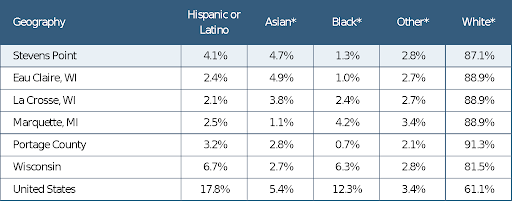
% CHANGE IN POPULATION BY RACE AND ETHNICITY, 2013-2018
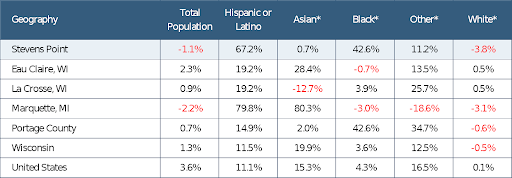
6) A diverse, stable, growing economy
- In contrast to its flat population growth, Portage County’s economy has expanded steadily in recent years, partially due to its diverse mix of employment sectors.
- Based on analysis by the University of Wisconsin-Madison’s Center for Research on the Wisconsin Economy (CROWE), Portage County is in the top third of best performing economies in Wisconsin during the COVID crisis.
- Online survey participants believe the top priorities for post-COVID recovery are support for small businesses, ensuring the most vulnerable residents are not left behind, and restoring the sense of community many felt was diminished during the pandemic.
TOTAL EMPLOYMENT CHANGE, 2009-2019

7) Entrepreneurial assets, but ecosystem challenges
- Stevens Point/Portage County currently has a smaller but faster growing small business sector than the benchmark communities.
- Public input found that there are local entrepreneurial success stories, but ambition is hamstrung by a scarcity of investment capital, a lack of mentors, oftentimes poor awareness of assets and resources, limited “meetup” and networking events, and a Midwestern “go it alone”/”reluctance to fail” mindset.
- Some also feel it is often hard to get “plugged in” to Stevens Points entrepreneurial community.
- The University of Wisconsin-Stevens Point is trying to “dip a toe” into the entrepreneurialism of sustainability, but its overall capacity is still limited.
PERCENTAGE OF TOTAL EMPLOYMENT COMPRISED BY SELF-EMPLOYED WORKERS, 2013-2018
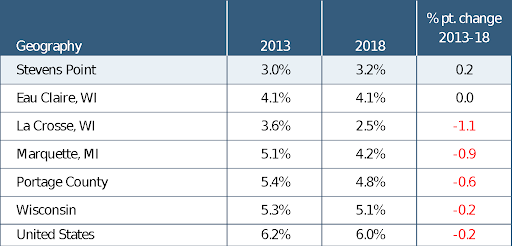
PERCENTAGE OF PRIVATE EMPLOYMENT AT FIRMS WITH 50 OR FEWER EMPLOYEES, Q4 2012 TO Q4 2017
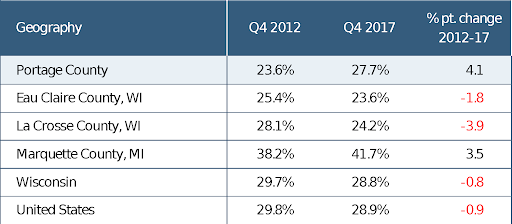
Future Vision
A goal of the Stevens Point Strategic Plan is to establish a vision for the city that will inform and shape future planning, investment, policies, and programs.
As many have noted, Stevens Point finds itself at a pivot point between a small college town and a growing city. Stakeholder preferences will help determine the direction and tactical stepping stones of the city’s path from present to future. A core tension will likely be the benefits and sacrifices of progress versus the desire to maintain what’s unique about Stevens Point.
This interviewee feedback was typical of many input sentiments. “My vision of Stevens Point isn’t fast growing, it isn’t Madison. The core part of Stevens Point is a small town with big city amenities. Protecting greenspace, minimizing sprawl, good water and food access is part of who we are.”
This viewpoint often clashed with stakeholders’ desire for new restaurants, retail, and housing along the Wisconsin River, a more “vertical” downtown, and entertainment, recreation, and cultural amenities that you might typically find in a larger community. Many residents are tired of seeing individuals and families leave the city for places that offer a more dynamic array of lifestyle assets.
The following word cloud is in response to the online survey question, “If you could wave a wand and create one new thing in Stevens Point, what would it be?”

Clearly, the wish list is long and includes much new development throughout the city, especially downtown and along the river. Selected open-ended responses to the question include:
- “A shopping/business/restaurant area that could be planned to allow growing accessibility from the Wisconsin River. We have jobs, but not enough people and this is needed to attract and keep people who come here to work.”
- “Utilize the riverfront more. I think developing some of the riverfront would draw in more people to visit and live here.”
- “Family-friendly water park/splash pad. We have nothing that very little kids can enjoy.”
- “A cultural community center/hub, something that celebrates, promotes, and increases the diversity of the area, enhances cultural understanding and opportunities, etc.”
- “Though there has definitely been progress, I’d say further work towards making it easy and safe to get basically anywhere in the city via bike.”
- “A better sense of inclusion, I know that city officials are working hard to create this already and it is greatly appreciated, but there has been a lot of intolerance and negativity that has been getting more attention recently.”
These ideas and others are consistent with projects that have been suggested and studied to varying degrees in Stevens Point for years. They will be part of the mix for discussion around the Strategic Plan’s priority projects. However, stakeholders’ vision for Stevens Point in ten years has little to do with physical development. Instead, it contrasts with one of the key words survey participants use to describe 2020 Stevens Point: “Divided.”
The following were the terms used most often in response to the question, “What are three WORDS or PHRASES you’d like to see used to describe Stevens Point in the year 2030?”
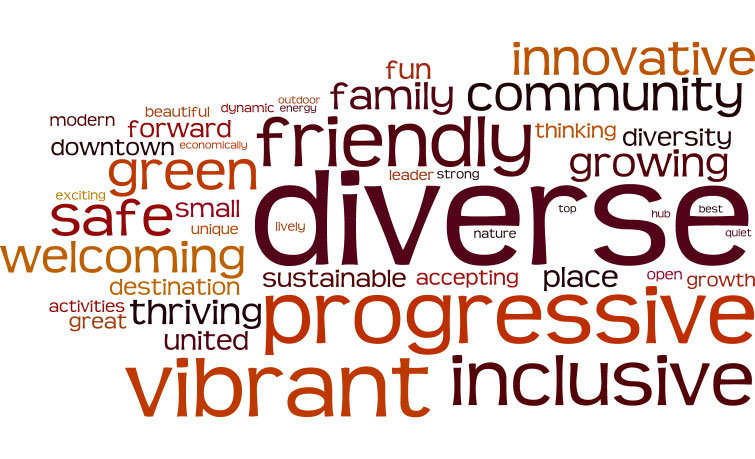
Strategic Opportunity Areas
Several potential strategic opportunity areas have emerged from the Stevens Point Community Assessment research and stakeholder feedback. These categories were the focus of discussions during and after the September 9 Steering Committee meeting as we worked to vet and confirm the highest impact projects, programs, and initiatives to advance through Stevens Point’s Strategic Plan.
The following categories represent the consultant team’s first pass at aggregating stakeholder feedback and ideas – coupled with analysis of existing efforts – into actionable opportunity areas for Stevens Point. They can be adjusted, removed, or replaced at the discretion of the Steering Committee and city officials.
Underlying these opportunity areas and potential projects should be a commitment to the green, sustainable, progressive, diverse, and inclusive future Stevens Point residents desire.
Opportunity areas include:
- Downtown and Riverfront
- Housing
- Arts and Culture Assets
- Talent Marketing
- Indoor Recreation
- “Green” Assets
- Entrepreneurial and
- Innovation Capacity
- Diversity and Inclusion
It is our belief that underlying many if not all these opportunity areas and potential projects should be a commitment to the green, sustainable, progressive, diverse, and inclusive future Stevens Point residents desire.

